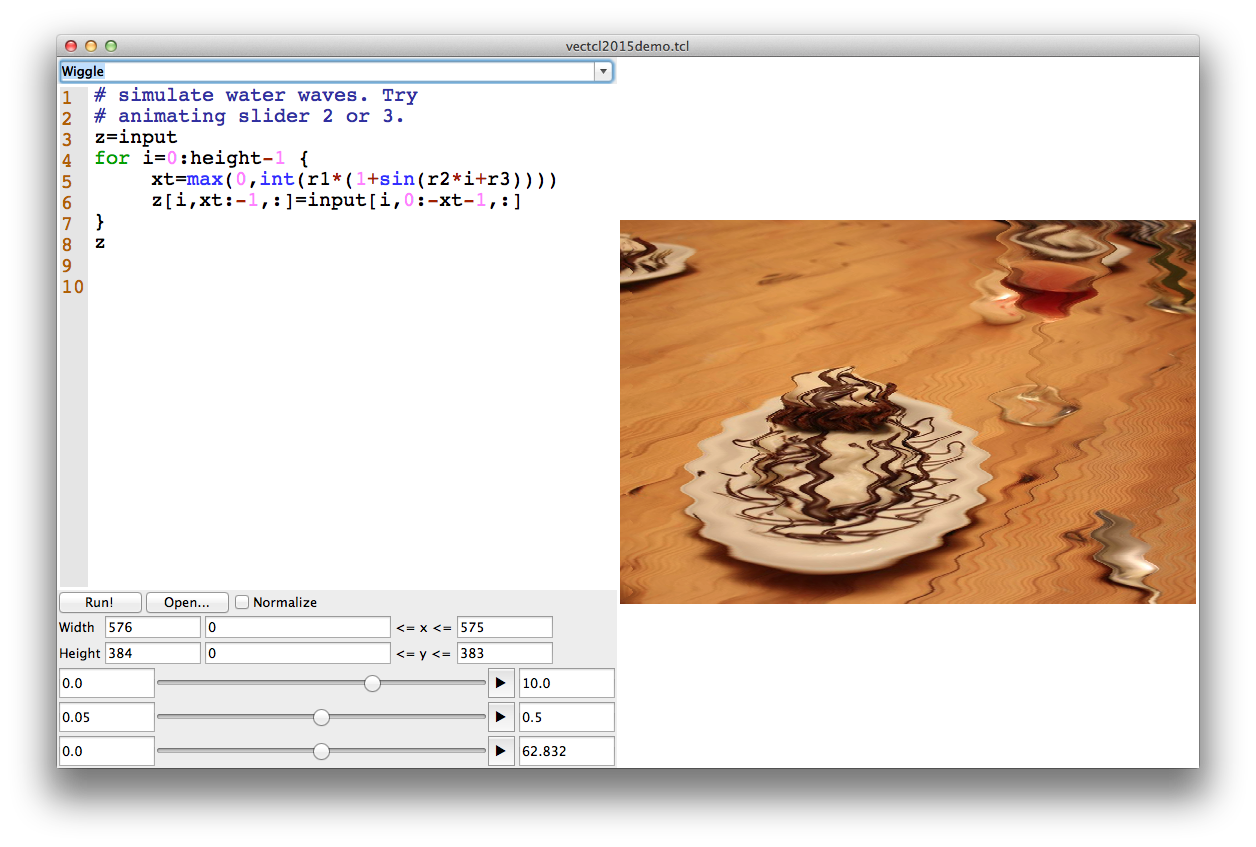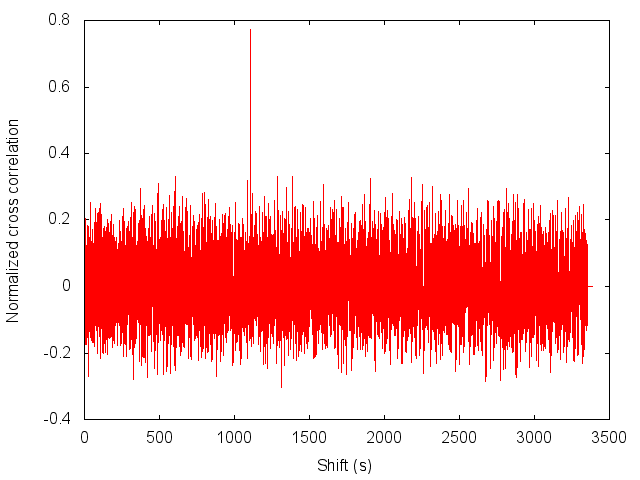VecTcl
Multimedia processing using VecTcl
Sound and image processing
Array languages such as Matlab and NumPy are often used to perform digital sound and image processing. Therefore these systems include facilities to read and write data from and to multimedia files and to display or play the data. In conjunction with a talk at EuroTcl 2015, some image and sound processing experiments were performed to demonstrate the suitability of VecTcl for these tasks and to discover possible limitations.
Image processing
For the talk, a demo application was prepared
which allows to manipulate an image by a VecTcl expression. To try it, open a
small image, select a code preset (e.g. Daytime or Wiggle) and pull the sliders
at the bottom underneath the code window. Click the image below for a video
demonstration of the program.

In order to read and write image data, a bridge was created between a Tk photo image and a VecTcl
array as a VecTcl extension
(vectk). This
extension must be loaded after VecTcl and Tk. In this
way, VecTcl itself does not link against Tk and continues to work in a pure Tcl environment.
The extension provides two new commands, numarray::fromPhoto and
numarray::toPhoto, which convert numerical arrays to and from a Tk photo
image. A grayscale image is stored as a 2D array of doubles, ranging from 0 to
1. The first coordinate represents the vertical and second coordinate the
horizontal axis. This convention was chosen such that it agrees with the
standard notation of matrices. A color image has an additional third dimension,
containing the red, green, blue, and alpha planes.
The demo program simply presets a few variables like height, width, and
input with the ipnut image and its dimensions. x and y are preset with
arrays of the same dimension as the input. This allows to use the demo as a 2D
function plotter, by evaluating an expression like
sin(x).*cos(y)For a demonstration of the manipulation of an image, try the Daylight or Wiggle preset, which manipulate the color planes and distort the image, respectively. The code is fast enough to process images of small size in real time.
Missing functionality and bugs
During the implementation of the demo script, a few limitations of VecTcl
surfaced. The first is the defect of an integer casting function, to be able to
compute coordinates within VecTcl. This could be easily changed, and an int()
downcasting function was added.
Another missing functionality is vector indexing. VecTcl currently supports
indexing like in a[3] by translating it into a slice reaching from 3 to 3
(3:3:1). This makes it possible to use the efficient slicing infrastracture
(NumArrayIterator) on indices and partial indices like a[3,2:5]. But there is
no way to express an arbitrary sequence of non-contiguous indices. Such a
feature is provided by other array languages and could be used to implement
image distortion very easily, like in the Wiggle example
ind=int(x+10*sin(y))
input[ind]The current code uses a for loop to iterate over the lines. It is still fast enough, but doesn’t generalize for arbitrary deformations, for instance it would not be possible to have the waves travel diagonally or do magnifications and such. Implementing indexing would require a major rethinking of the slicing infrastructure, but is certainly worth it. A Tcl level loop running over all pixels would be an order of magnitude slower than that.
Sound processing
At the EuroTcl 2015 event, the talks have been recorded using a Canon EOS 550D DSLR. Sound was additionally captured by a portable Zoom H2n recorder, attached to the speaker using a belt clip. While the DLSR provides excellent video quality, the sound is poor due to the large distance to the speaker. Additionally, the recording stops after ~15 min and resumes only a few seconds later. In order to synchronize the externally recorded sound with the video, almost 40 movies need to be aligned to the soundtrack.
As an experiment, a program was developed using VecTcl which automatically synchronizes the videos to the external soundtrack based on the matching to the internal sound. Before the computation can be done, the sound data must be converted into a VecTcl array. This is accomplished by another extension, which reads in WAVE files, WavReader. This is extension is currently restricted to little endian machines and 16 bit PCM wave files, however that is the most common case.
Pattern matching in signal processing is usually done using some kind of correlation function. In this case, it makes no sense to do a direct cross-correlation of the raw audio data, because the phase of the sound between both microphones is different. Instead, the sound matching program first reduces the audio data into a loudness profile, by dividing the track into frames of 20 ms and computing the RMS value of each frame. The RMS data is then matched (with an accuracy of 20 ms) between both recorded tracks using shifted normalized cross-correlation. It works extremely well for this setting.

The above figure displays the cross correlation of one of the recorded movie fragments to the separate soundtrack. The sharp spike at 1104 s corresponds to the shift to match both sound tracks. It can be easily detected by finding the maximum, and is accurate to within one frame.
Missing functionality and bugs
Implementing the sound processing revealed a bug in basic VecTcl, an integer overflow for arrays larger than 2GB on 64bit systems. That bug was fixed. Extensions to VecTcl need to be recompiled.
A more general missing feature is the availability of fixed-width integer arrays. If VecTcl could handle 16 bit integers natively, there would be no need to convert the whole soundfile to double precision floating point upon loading, thus cutting down the memory requirements by a factor of four. It would also allow more general file handling of polymorphic files. For example, a wave file can also contain 32bit floating point data instead of 16bit integers. The TIFF file format can contain almost any standard integer and floating point data from 8bit up to 64bit. Support for more integer and floating point data types would enable VecTcl to read and write such files in a lossless way.
However, in the current code base, polymorphic data is handled by preprocessor macros, which push the C preprocessor to its limits. Scaling up the data types from currently 3 (64bit integer, double, complex double) to a large number of signed and unsigned integers of different size, real and complex floating point of different size, would drastically increase these tables until they become unmanageable. Another solution, using either a Tcl script to generate the C code or C++ templates, must be sought. So far, VecTcl refrained from using the C++ compiler, but if this provides the best options, this decision needs to be reconsidered.
Conclusion
- VecTcl is suitable for multimedia processing in its current state. However, a bit functionality is still missing
- Most pressing would be indexing, to allow for fast distortion/interpolation operations
- Finite width data types and bignums are next on the wishlist, however this calls for an architectural change
- Minor missing functionality, like standard math functions, cross correlation primitives or I/O for multimedia files can be added with a few lines of code